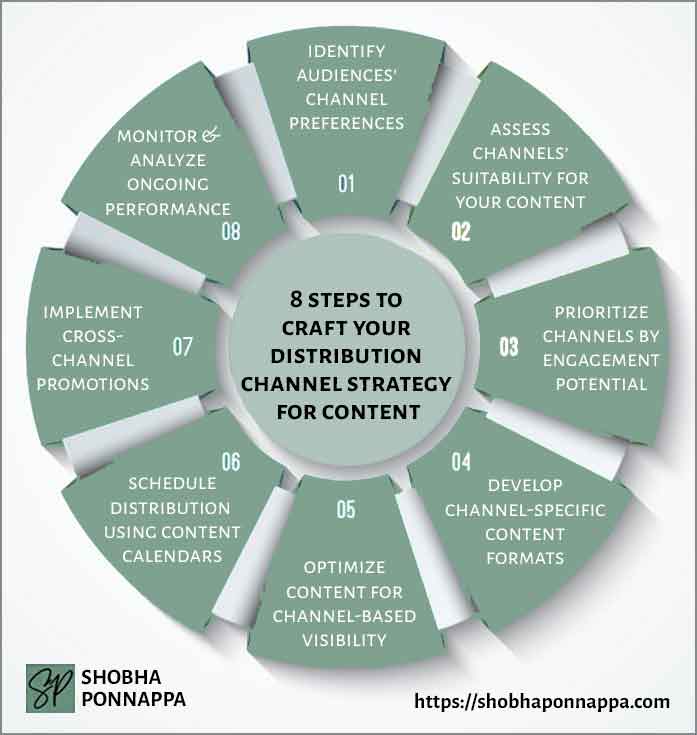
Creating compelling content is only half the battle. Without an effective distribution channel strategy, even the most brilliant content can go unnoticed.
Finding the right channels to reach your target audience and delivering content in a format that resonates with them is crucial for success.
However, in today’s saturated digital environment, conventional approaches may not always yield the desired results.
To truly stand out, your distribution strategy must strike a balance between tried-and-tested methods and innovative, out-of-the-box thinking.
A distribution channel strategy is instrumental in amplifying the reach and impact of brand content. By carefully selecting and leveraging various channels, brands can effectively deliver their message to their target audience. This strategy ensures that content reaches the right people at the right time and in the right format, maximizing engagement and interaction.
A well-crafted distribution channel strategy helps brands differentiate themselves in a crowded marketplace, allowing them to stand out from competitors and capture the attention of consumers. Moreover, it facilitates brand visibility and recognition, as consistent exposure across multiple channels reinforces brand identity and fosters trust and loyalty among consumers.
Additionally, a robust distribution channel strategy enables brands to adapt to changing consumer preferences and behaviors, ensuring relevance and resonance in an ever-evolving digital landscape.
Ultimately, by aligning content distribution with overarching brand objectives, a distribution channel strategy becomes a powerful tool for driving brand awareness, affinity, and business success.
Drawing from my “Unusual By Strategy” forte, I consistently advocate for a blend of proven and unconventional tactics in crafting a distribution channel strategy. Embracing this approach stems from the recognition that while conventional methods offer reliability, innovation often leads to differentiation and breakthroughs.
By combining time-tested approaches with unconventional ideas, brands can not only establish a solid foundation but also seize new opportunities for growth and engagement. This dual approach ensures adaptability in dynamic market environments and fosters a culture of continuous experimentation and improvement.
Moreover, integrating unusual elements into the strategy reflects a commitment to standing out in saturated digital spaces, where attention is scarce and competition is fierce.
Ultimately, by marrying the best of both worlds, brands can create distribution channel strategies that are not only effective in reaching their audience but also memorable and impactful in driving brand awareness and engagement.
Leveraging my 40+ years’ experience as a Brand Content Strategist with a penchant for the unusual, I’ve curated eight innovative ideas that infuse time-tested approaches with unconventional twists to supercharge your distribution channel strategy. From targeting niche audience segments on traditional platforms to harnessing emerging trends for maximum impact, each idea combines the reliability of proven methods with the creativity of out-of-the-box thinking.
By embracing this hybrid approach, brands can not only expand their reach and engagement but also carve out a distinctive presence in today’s competitive landscape, ensuring their content stands out amidst the noise and resonates deeply with their target audience.

Identifying target audience channel preferences is a cornerstone of effective distribution channel strategy for content marketing. By understanding where your audience spends their time online, you can tailor your content distribution efforts to reach them where they are most active and engaged.
For instance, suppose you’re promoting a new line of eco-friendly home products. Researching your target demographic reveals that environmentally conscious consumers frequently engage with sustainability-focused blogs, social media groups dedicated to green living, and online forums discussing eco-friendly lifestyle choices.
Armed with this knowledge, you can prioritize these channels for distributing your content, whether it’s through guest blogging opportunities on sustainability websites, sponsoring posts on relevant social media pages, or actively participating in discussions within eco-friendly online communities.
By aligning your distribution strategy with your audience’s preferences, you can effectively connect with them on platforms they trust and resonate with, ultimately driving greater awareness and engagement for your brand’s content.

Consider the idea of “Sentiment Analysis Mapping.” Instead of relying solely on demographic data and online behavior analysis, take it a step further by utilizing sentiment analysis tools to map out the emotional landscape of your target audience across various channels. This enhancement allows you to identify not just where your audience is active, but also how they feel about different topics and brands in those spaces.
For example, by analyzing sentiment, you may discover that while your eco-friendly home products resonate well with environmentally conscious consumers on social media, there’s a growing interest in sustainability-related podcasts where listeners express enthusiasm for innovative green solutions. This insight enables you to expand your distribution strategy to include podcast sponsorships, tapping into an audience segment that aligns perfectly with your brand’s values.
Assessing channels’ suitability for your content is fundamental to crafting an effective distribution channel strategy in content marketing. It involves evaluating various platforms to determine their alignment with your brand message, target audience, and content format.
For instance, if you’re a fashion brand launching a new collection, platforms like Instagram and Pinterest might be ideal due to their visual nature and popularity among fashion enthusiasts. However, if you’re offering B2B software solutions, LinkedIn and industry-specific forums may be more suitable for reaching decision-makers and tech professionals.
By carefully assessing each channel’s suitability, you can ensure that your content resonates with the right audience in the right context, maximizing engagement and conversion opportunities.
This approach not only helps in reaching your target demographic but also strengthens your brand’s positioning and credibility within relevant communities.

Consider the idea of “Psychographic Alignment Analysis.” Rather than solely focusing on demographic data, delve into the psychographic profiles of each platform’s user base to ensure a deeper alignment between your content and audience values, interests, and behaviors. This enhancement involves using advanced analytics tools to identify not just who your audience is, but also why they engage with specific platforms and what motivates their online interactions.
For instance, while Instagram and Pinterest may attract visually-oriented fashion enthusiasts, a psychographic analysis might reveal that Instagram users value creativity and self-expression, while Pinterest users prioritize inspiration and DIY culture. By leveraging this insight, you can tailor your content strategy to resonate more deeply with the underlying motivations of each platform’s audience, fostering stronger connections and driving higher engagement levels.
Prioritizing channels by engagement potential is a cornerstone of crafting a successful distribution channel strategy in content marketing. By focusing on platforms where your target audience is most active and responsive, you can maximize the impact of your content and drive meaningful interactions.
For example, if you’re promoting a new line of fitness apparel, platforms like Instagram and YouTube might be top priorities due to their visual nature and strong community of health and fitness enthusiasts.
These platforms offer opportunities for immersive storytelling through visually compelling content such as workout tutorials, transformation stories, and behind-the-scenes glimpses of product development.
By prioritizing channels with high engagement potential, brands can not only increase their reach and visibility but also foster deeper connections with their audience, ultimately leading to increased brand loyalty and advocacy.

Consider the idea of “Emotional Connection Index.” Rather than solely relying on quantitative engagement metrics, introduce a qualitative measure that evaluates the emotional resonance of each channel with your target audience. This enhancement involves conducting surveys or focus groups to gauge the emotional connection that users feel toward different platforms and content types.
For instance, while Instagram may boast high engagement metrics in terms of likes and comments, a deeper analysis might reveal that users feel a stronger emotional connection with content shared on Pinterest due to its focus on aspiration and inspiration. By prioritizing channels based on their Emotional Connection Index, brands can ensure that their content resonates more deeply with the audience, fostering genuine connections and loyalty.
Tailoring content formats to suit each distribution channel is a fundamental aspect of content marketing strategy. By adapting the format of your content to match the preferences and expectations of users on different platforms, you can enhance engagement and maximize reach.
For example, if you’re promoting a new recipe book, you might create visually appealing recipe cards and cooking tutorial videos for platforms like Instagram and YouTube, where users often seek inspiration and entertainment.
On the other hand, for a professional audience on LinkedIn, you might develop informative articles or slide presentations highlighting the nutritional benefits of the recipes and their potential impact on productivity and well-being.
By developing channel-specific formats for your content, you not only cater to the unique preferences of each platform’s audience but also optimize the effectiveness of your distribution efforts, ultimately driving greater visibility and engagement for your brand.

Consider the idea of “Adaptive Content Matrix.” Implement a dynamic content matrix that not only tailors content formats to different channels but also adapts them based on real-time user interactions and preferences. This enhancement involves leveraging machine learning algorithms to analyze user engagement data and automatically adjust content formats to maximize effectiveness.
For example, if a particular video format receives higher engagement rates on Instagram compared to images, the Adaptive Content Matrix would prioritize video content for that platform and continuously refine the format based on audience response. By adopting this approach, brands can ensure that their content remains relevant and impactful across various channels, leading to increased audience engagement and brand resonance.
Optimizing content for channel-based visibility is a critical aspect of content marketing strategy, ensuring that your content stands out and reaches its intended audience on each platform. By tailoring your content to the unique features and algorithms of different channels, you can increase its chances of being discovered by users and appearing prominently in their feeds.
For example, on social media platforms like Facebook and Twitter, optimizing content may involve using relevant hashtags, engaging visuals, and concise captions to grab users’ attention amidst a cluttered feed.
Similarly, for search engine optimization (SEO), optimizing content may entail incorporating targeted keywords, meta tags, and descriptive titles to improve its visibility in search engine results pages (SERPs).
By implementing channel-specific optimization techniques, brands can enhance the visibility of their content across various platforms, driving traffic, engagement, and ultimately, achieving their marketing objectives.

Consider the idea of “Semantic Enrichment.” Implement a semantic enrichment strategy to optimize content for enhanced visibility across channels. This enhancement involves leveraging natural language processing (NLP) and machine learning algorithms to analyze the context and meaning of your content and enriching it with semantically related keywords and concepts.
For example, if you’re promoting a new line of eco-friendly home products, semantic enrichment would identify related terms such as sustainability, green living, and environmental consciousness, and seamlessly integrate them into your content. By enhancing the semantic relevance of your content, you can improve its visibility and searchability across various channels, reaching a broader audience and driving higher engagement levels.
Scheduling distribution using a content calendar is a fundamental practice in content marketing, providing structure and organization to your distribution efforts across various channels. By planning and scheduling content in advance, brands can ensure consistency in their messaging and maintain a steady flow of engagement with their audience.
For instance, a fashion brand launching a new collection might use a content calendar to schedule Instagram posts teasing the upcoming release, followed by blog articles showcasing the inspiration behind the designs, and concluding with YouTube videos featuring behind-the-scenes footage of the photo shoot.
By mapping out content distribution in advance, brands can effectively manage resources, maintain a cohesive brand narrative, and capitalize on key events and trends to maximize visibility and engagement.
Additionally, a content calendar enables brands to optimize distribution timing based on audience behavior and platform algorithms, ensuring that content reaches its intended audience at the most opportune moments.

Consider the idea of “Dynamic Content Calendar.” Implement a dynamic content calendar that incorporates machine learning algorithms to optimize distribution timing based on real-time audience engagement data and platform trends. This enhancement allows the content calendar to automatically adjust publishing schedules, prioritizing times when audience activity and interaction levels are at their peak.
For example, if analytics indicate that engagement on Instagram spikes during evenings and weekends, the dynamic content calendar would schedule posts accordingly, maximizing visibility and interaction opportunities. By leveraging predictive analytics and automation, brands can ensure that their content reaches the right audience at the most opportune moments, driving higher engagement and maximizing the impact of their distribution efforts across various channels.
Implementing cross-channel promotion strategies is a proven approach in content marketing, enabling brands to maximize the reach and impact of their content by leveraging multiple platforms and channels.
By strategically coordinating promotional efforts across various channels, brands can amplify their message and engage with audiences at different touchpoints throughout their online journey.
For example, a tech company launching a new product might utilize cross-channel promotion by teasing the product on social media platforms like Twitter and LinkedIn, directing interested users to sign up for an exclusive webinar on the company’s website, and following up with email campaigns containing product demos and special offers.
This integrated approach ensures that the product launch garners attention from a diverse audience across different channels, driving traffic, generating leads, and ultimately, boosting sales. Cross-channel promotion strategies allow brands to create a cohesive brand experience for their audience while maximizing the effectiveness of their content distribution efforts.

Consider the idea of “Sequential Content Layering.” Implement a sequential content layering strategy that strategically distributes interconnected content pieces across different channels in a sequential order, creating a narrative arc that compels users to engage across multiple touchpoints. This enhancement involves crafting a series of content pieces, each designed to build upon the previous one and drive users through a predetermined journey.
For example, the tech company launching a new product could start by teasing the product on social media platforms like Twitter and LinkedIn, then follow up with informative blog posts on its website, and conclude with interactive live demos on YouTube. By orchestrating sequential content layers, brands can create a cohesive storytelling experience that captivates audiences and maximizes engagement across various channels.
Continuously monitoring and analyzing performance metrics is a cornerstone of effective content marketing strategy, ensuring that brands can adapt and optimize their distribution channel strategies based on real-time data insights.
By closely tracking key performance indicators such as engagement rates, click-through rates, conversion rates, and audience demographics, brands can gain valuable insights into the effectiveness of their content across different channels.
For example, a fashion retailer might regularly analyze performance metrics to identify which social media platforms drive the highest traffic and sales for their online store. They may discover that Instagram generates the most engagement for their product launch campaigns, prompting them to allocate more resources towards creating visually compelling content for that platform.
Additionally, by monitoring performance continuously, brands can identify trends, detect anomalies, and capitalize on opportunities to refine their distribution channel strategies, ultimately driving greater visibility, engagement, and ROI for their content efforts.

Consider the idea of “Predictive Performance Forecasting.” Implement predictive analytics models to forecast future content performance based on historical data and trend analysis. This enhancement involves leveraging machine learning algorithms to analyze past content performance metrics, audience engagement patterns, and external factors to predict the potential outcomes of future content distribution efforts.
For example, the fashion retailer could use predictive performance forecasting to anticipate the impact of different promotional campaigns on sales and website traffic, allowing them to allocate resources more effectively and optimize their distribution channel strategy proactively. By adopting this approach, brands can stay ahead of the curve, anticipate market trends, and make data-driven decisions to maximize the success of their content marketing efforts.

"As a Content/Brand Specialist, and SEO/UX Writer, I can help transform your brand's online presence. I can lift it with innovative ideas to take it to an enviable position. Let's collaborate to create a captivating brand story, engage your audience, boost your online visibility, and increase your ROI. Take the next step towards your brand content success and contact me today."
Shobha Ponnappa
I Bring You:
Content Marketing That’s “Unusual By Strategy” … Tips, Tricks, Tactics, Techniques, Trends, Training.
Get my weekly ContenTracker Newsletter packed with loads of content marketing ideas – proven and unusual.
Get a free download of my ebook on “50 Unusual Ways To Use AI In Content Marketing” … and transform your success.

Just fill in the form to join my community … we have big and small brands for company. You’ll stay on the speedway to growth.
KEY TOPIC CATEGORIES COVERED ON THIS SITE:
COPYRIGHT © 2025. SHOBHAPONNAPPA.COM. ALL RIGHTS RESERVED.

Just fill in this form and get this awesome guide via email. Plus … each fortnight you’ll receive my Brand Reframe Newsletter that brings you smart insights, distilled thinking, and focused brand momentum.